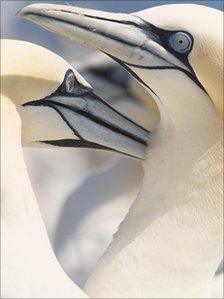Tracking devices trace secrets of Pembrokeshire birds
- Published

It is hoped the study will improve knowledge of gannets' behaviour
Scientists are using satellite tracking devices on seabirds' legs on two Pembrokeshire RSPB reserves to shed light on their movements in the winter.
The study, on Ramsey and Grassholm for the past four years, sees devices attached to birds such as gannets.
The research focuses on how the bird population has doubled since the removal of brown rats ten years ago.
Early indications show the gannets winter on the west coasts of the Iberian Peninsula or north west Africa.
It is a collaboration between scientists from the Universities of Plymouth, Exeter and Oxford.
It is linked to studies concerning the behaviour of Ramsey's Manx shearwater birds.
The devices weigh 2.5g and are about the size of a 10p piece and are attached to each bird's leg on a plastic ring.
They then estimate the location of the seabirds using longitude and latitude measurements.
Whenever a tagged bird enters the sea to forage for food, a saltwater immersion switch is triggered.
Because both types of bird return to the same nesting site every year, provided the bird survives the winter, the researchers are able to retrieve the devices the following year and study any data collected.
Scientists have been tracking seabirds on Grassholm Island in Pembrokeshire since 2006
Dr Steve Votier, of the University of Plymouth said: "This ongoing work is allowing us to build a reliable picture of where Grassholm's gannets are foraging and spending the winter, something relatively little was known about until now.
"To date we have deployed 57 devices and had successful data returned from 12.
"The results are only preliminary, but early indications are of two distinct wintering grounds for these gannets - the west coast of the Iberian peninsula or the west coast of north west Africa."
Dr Votier also switched the focus of part of the study to non-breeding gannets in 2009, attaching five tracking devices to the birds.
It was the first time the trackers had been fitted to non-breeding birds and should allow "real-time" observation of where they have flown to during the summer.
Professor Tim Guilford from Oxford University added: "The work we have carried out on Manx shearwaters at Skomer up to now has been well documented and revealed many fascinating and previously unknown data about the year round movements of these birds.
"It is hoped the work on Ramsey will complement these findings and offer an insight into how an expanding population is responding to freedom from predation, following the removal of brown rats ten years ago."
More than 39,000 pairs of northern gannet choose Grassholm as a breeding destination, making it one of the most important sites in the world for the species.